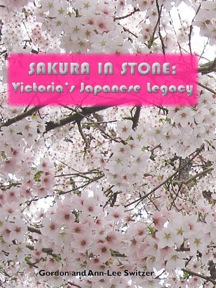Mar
8
A Book Review by Ted Ross
 Sakura in Stone, Gordon and Ann-lee Switzer, Victoria BC, Ti-Jean Press, 2015, 102pp paperbound, illus., cemetery map, gravesite roster, footnotes, index, $14.95, ISBN 978-1-896627-21-2.
Sakura in Stone, Gordon and Ann-lee Switzer, Victoria BC, Ti-Jean Press, 2015, 102pp paperbound, illus., cemetery map, gravesite roster, footnotes, index, $14.95, ISBN 978-1-896627-21-2.
Who knew the first Japanese immigrants to Canada landed in Victoria? Or that there are 155 Japanese gravesites in Ross Bay Cemetery (RBC)?
In a fascinating volume, our authors trace the arrival of the first Japanese person in Victoria, a shipwrecked sailor, and the later Japanese immigrants and their influence in the city, until their expulsion to the mainland interior in 1942.
Did you ever wonder why so many Sakura (Japanese Flowering Cherry) trees bloom in the city? You'll learn how Parks Superintendent Herb Warren, with Japanese benefactors, had these beauties planted all over Victoria late in the 1930s.
The authors, Gordon and Ann-Lee Switzer, are historians; both have the Japanese language. They are published in several genres, but take an especial interest in the Japanese culture as once found in Victoria. Members of the Old Cemeteries Society, they are most familiar with the Japanese burial sites in Ross Bay.
Their book has three sections. The first, "Japanese in Victoria," deals with the history of those immigrants in the city. The next, "The First Settler," tells the story of Kisuke Mikuni, an early, and probably the first, Japanese settler in Victoria. The following section, "The Other Shore," tells the story of the rehabilitation of Japanese graves at RBC. It offers, as well, stories of the people interred in eleven different areas in the cemetery.
Typical of the historical pages is the following, "During the war years, Rinbel Shimizu set up a business importing Japanese goods from Japan to sell to Japanese residents of Victoria. Around 1915 he took over a space at 1625 Store Street off Fisgard in Chinatown. He converted it into a dry goods store selling items such as Lion's tooth powder, cones for moxa, chinaware, cotton and canned goods. At the back of the store Shimizu set up rice-milling machinery to polish natural brown rice shipped from Japan. The Shimizu enterprise grew to become the main supplier of rice and other Japanese food items on Vancouver Island until 1927."
The stories of the past are accompanied by contemporary photographs from assorted archival and family sources. On the high grade paper which this book is printed, and with the good quality of the original images, the pictures are clear and well-defined.
Illustrating the gravesite stories, "It was not all work for Bumpei; he had his hobbies. Golf was something he enjoyed playing, and he often took his sons to the golf course to let them practice... He was an avid gardener, filling the yard with vegetables and flowers. His specialty was chrysanthemums, which he guarded and pruned with special care. Alice remembers, 'Many a night he would be out checking his 'mums for earwigs with a flashlight. He won many prizes in 'mum shows.'"
In "The Other Shore" we grasp the appropriateness of the book's title. Reconditioned Japanese graves are marked, "with individual markers of grey granite with a stylized sakura above the name, age and date of death."
Sakura in Stone has been well researched. A photograph of a ledger which was found in the BC Archives from the late 1880s shows the use of primary sources in putting the history together. As well as English language titles, the Svitzer’s were able to do research in Japanese language materials. These show in the footnotes.
This is a wonderful addition to the library of little histories we find of the city of Victoria. It tells the story of a forgotten people once in the weave of Victoria society. The course of the first Japanese settler is traced through his life in Victoria, the Gulf Islands and on the mainland in Steveston and New Westminster. The book then takes you on a marvellous walk through Ross Bay Cemetery, while you load up on history through stories and pictures. This volume is definitely worth reading.
Available at local booksellers and on-line from amazonbooks.com $14.95
